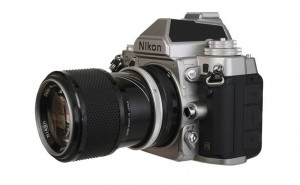
I’ve been really enjoying using my Nikon Df, and really think its niche is much larger than a lot of people assume. Yes, it’s true that the most ecstatic of my emails about this camera have been coming from the over-50 crowd, so it’s impossible to deny that the strongest appeal of this camera is, indeed, among the old fogeys. However, after you’ve used the Nikon Df for awhile, it’s easy to see that there is much more to this camera than nostalgia. Although my Df guidebook, which should be available in February, has a retro appearance, like the Df itself it will delve much deeper.
* The Df is the true replacement for the Nikon D700, and is even priced in the same ballpark. The original D700 had the same sensor as the D3 — a useful and almost noise-free 12 megapixels. The Df and D4 up the ante to 16 megapixels, which I’ve found is enough for virtually all of my work. Because of its superior overall image quality over a broader range of ISO settings, my D4 has supplanted my D800 even for a lot of studio work, landscapes, and wildlife (which were originally what I used the D800 for.) Unless I’m making huge prints, I expect the Df will move the D800 into third place on my equipment list
* It’s a super-compact D4 that’s great for travel. I carried my D4 around Barcelona — a maritime city — for a week, and, appropriately, it felt like I was carrying a boat anchor around my neck. After that, my D7100 became my travel camera when I am slimming my kit down to one body and two lenses (plus a Powershot G16 for backup.) I’d rather stick to an FX body, because I can easily get by with a 17-35mm f/2.8 zoom and my favorite 3 x 3-inch super compact 28-200mm Nikkor G.
* The Df isn’t perfect for travel, however. It has only one memory card slot, and I like the ability to save to a pair of cards (which is possible with my D4, D800, or D7100.)
* The Df is the perfect walk-around camera. With that tiny 28-200mm G lens, I can take this camera with me even when I am not intending to take pictures.
* The Df is versatile enough to do just about everything the D4 does (which the D800 and D7100 cannot), so I don’t leave anything at home except extra megapixels that I probably won’t miss. Yes, the Df shoots at a slower frame rate, so I wouldn’t use it instead of the D4 at concerts or for sports. It’s not the most convenient camera to use for long exposures, and when I want to shoot video I’ll have to take along an additional camera. But from an exposure and dynamic range standpoint, it’s less finicky than the D800, and makes better use of my wide angle lenses than the D7100. Your mileage and needs may vary, but from my standpoint, the Df really is a mini-D4.
* Okay, the retro look/operation is fun, even if I don’t think it’s the most important aspect of this camera. I’ve enjoyed using some of the oldest lenses in my closet, including a perspective control Nikkor I hadn’t mounted in ages, and my immortal 1968-vintage 105mm f/2.5 portrait lens. And, if you want to use the worst lens Nikon ever made, you can do it, as the image accompanying this post shows. While I don’t have a yen to use my old threaded cable release, I have to admit there’s a bit of fun working with my silver-model Df. I didn’t swoon when I saw the top-panel dials and controls, but they can be gotten used to. The only thing I really miss is the ability to turn the camera on and off more easily with my index finger
*The Df isn’t really over-priced. Yeah, a nostalgia piece with no video and “only” 16 megapixels might seem pricey. But I don’t buy a dSLR based on megapixels — I look at overall dynamic range and image quality. And for a mini D4, the Df is priced quite reasonably. If I didn’t shoot so much sports and action, I’d be perfectly happy with it as my main camera. I’ve owned both the Nikon D600 and D610, and still own the D800, D7100, and the D5000/D5100, and current D5300, and can’t say the same about any of them.
Thank you, Nikon!